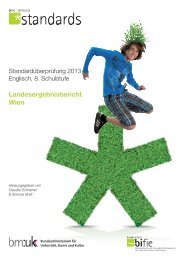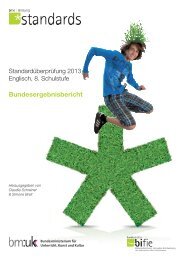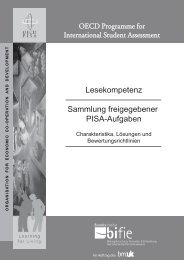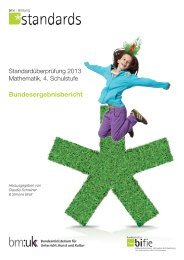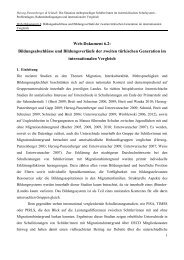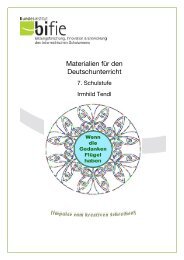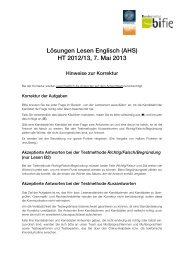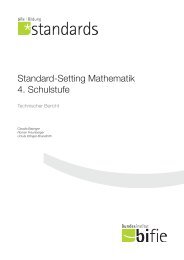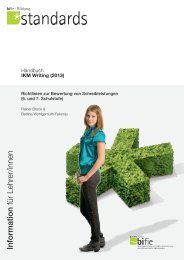Standardisierte kompetenzorientierte Reifeprüfung I Reife - Bifie
Standardisierte kompetenzorientierte Reifeprüfung I Reife - Bifie
Standardisierte kompetenzorientierte Reifeprüfung I Reife - Bifie
Sie wollen auch ein ePaper? Erhöhen Sie die Reichweite Ihrer Titel.
YUMPU macht aus Druck-PDFs automatisch weboptimierte ePaper, die Google liebt.
B2 Lexical and Structural Range<br />
Assessment Scale B2<br />
B2 Lexical and Structural Accuracy<br />
10<br />
• (1) Expresses him / herself very clearly without any sign of having to<br />
restrict what he / she wants to say<br />
• (2) Uses a very good variety of structures<br />
• (3) Uses a range of complex structures / sentence forms<br />
• (4) Uses a very wide range of vocabulary for the set task<br />
• (5) Varies formulation to avoid repetition*<br />
• (6) Expresses him / herself very confidently, clearly and politely in a formal<br />
or informal register appropriate for the set task<br />
• (7) Uses a very good range of language to give clear descriptions /<br />
express viewpoints / develop arguments as required in the set task<br />
10<br />
• (1) Very good structural control<br />
• (2) Hardly any slips or errors<br />
• (3) Excellent control of spelling<br />
• (4) Lexical accuracy is very high; hardly any incorrect word choice<br />
• (5) Highly accurate use of linking devices<br />
• (6) Meets all expected standard punctuation conventions<br />
• (7) No re-reading necessary<br />
9 9<br />
8<br />
• (1) Expresses him / herself clearly without much sign of having to restrict<br />
what he / she wants to say (B2.2 GLR)<br />
• (2) Uses a good variety of structures<br />
• (3) Uses a range of complex structures / sentence forms<br />
• (4) Uses a wide range of vocabulary for the set task<br />
• (5) Varies formulation to avoid repetition*<br />
• (6) Expresses him / herself confidently, clearly and politely in a formal or<br />
informal register appropriate (B2.2 SA) for the set task<br />
• (7) Uses a good range of language to give clear descriptions / express<br />
viewpoints / develop arguments as required in the set task<br />
8<br />
• (1) Good structural control<br />
• (2) Occasional slips or non-systematic errors and minor flaws in sentence<br />
structure may still occur, but they are rare (B2.2 GA)<br />
• (3) Good control of spelling<br />
• (4) Lexical accuracy is high; occasional incorrect word choice does not<br />
hinder communication<br />
• (5) Accurate use of linking devices<br />
• (6) Meets almost all expected standard punctuation conventions<br />
• (7) No re-reading necessary<br />
7 7<br />
6<br />
• (1) Expresses him / herself clearly though there may be some signs of restriction<br />
• (2) Uses some variety of structures<br />
• (3) Uses some complex structures / sentence forms (B2.1 GLR)<br />
• (4) Uses a good range of vocabulary to cope with the set task (B2 VR)<br />
• (5) Varies formulation to avoid frequent repetition* (B2 VR)<br />
• (6) Occasional lifting of words from the prompt may occur<br />
• (7) Expresses him / herself appropriately in the set task (B2.1 SA)<br />
• (8) Uses a sufficient range of language to give clear descriptions / express<br />
viewpoints / develop arguments (B2.1 GLR) as required in the set task<br />
6<br />
• (1) Good control of frequent patterns and structures<br />
• (2) Any structural mistakes do not cause misunderstanding (B2.1 GA)<br />
(Manual table C4)<br />
• (3) Mistakes in spelling occur but do not hinder communication<br />
• (4) Lexical accuracy is reasonably high on the whole; any incorrect word<br />
choice does not usually hinder communication (B2 VC)<br />
• (5) Relatively accurate use of linking devices<br />
• (6) Meets most of the expected standard punctuation conventions<br />
• (7) Reader seldom has to stop to re-read<br />
5 5<br />
4<br />
• (1) Occasionally unable to express him / herself clearly<br />
• (2) Uses a limited variety of structures<br />
• (3) Only occasionally uses complex structures / sentence forms<br />
• (4) Uses a limited range of vocabulary to cope with the set task<br />
• (5) Few attempts to vary formulation*<br />
• (6) Some lexical limitations cause repetition and / or frequent lifting of words<br />
from the prompt<br />
• (7) Sometimes fails to express him / herself appropriately in the set task<br />
• (8) Uses a limited range of language to give clear descriptions / express<br />
viewpoints / develop arguments as required in the set task<br />
3 3<br />
2<br />
• (1) Frequently unable to express him / herself clearly<br />
• (2) Uses little / no variety of structures<br />
• (3) Uses hardly any complex structures / sentence forms<br />
• (4) Uses only basic vocabulary<br />
• (5) No attempts to vary formulation* (B1.1 GLR)<br />
• (6) Lexical limitations frequently cause repetition (B1.1 GLR) and / or<br />
lifting of words from the prompt<br />
• (7) Frequently fails to express him / herself appropriately in the set task<br />
• (8) Fails to use a range of language to give clear descriptions / express<br />
viewpoints / develop arguments as required in the set task<br />
1 1<br />
4<br />
2<br />
• (1) Limited control of frequent patterns and structures<br />
• (2) Errors occur and structural mistakes sometimes cause misunderstanding<br />
• (3) Noticeable lexical and structural influence from other languages<br />
• (4) Spelling frequently inaccurate<br />
• (5) Good control of elementary vocabulary but major errors still occur<br />
when expressing more complex thoughts (B1 VC)<br />
• (6) Lexical inaccuracies sometimes impede communication<br />
• (7) Some inaccurate use of linking devices<br />
• (8) Meets only some of the expected standard punctuation conventions<br />
• (9) Requires effort on the part of the reader (B1.2 GA)<br />
• (1) Hardly any structural control<br />
• (2) Mistakes repeatedly cause misunderstanding<br />
• (3) Accuracy limited to frequently used routines and patterns<br />
• (4) Spelling frequently inaccurate<br />
• (5) Lexical inaccuracies prevent communication<br />
• (6) Inaccurate use of linking devices<br />
• (7) Fails to meet the expected standard punctuation conventions<br />
• (8) Reader frequently has to stop to re-read sections<br />
0 • (1) Insufficient language to make an assessment 0 • (1) Insufficient language to make an assessment<br />
© Bundesinstitut für Bildungsforschung, Innovation & Entwicklung des österreichischen Schulwesens<br />
* at the phrase/expression level – e.g. however / nevertheless / then again etc.



